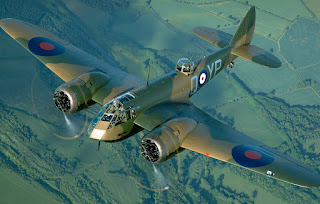Bombers Military
The Bristol Blenheim is a British light bomber aircraft designed and built by the Bristol Aeroplane Company (Bristol) which was used extensively in the first two years and in some cases throughout the Second World War. The aircraft was developed as Type 142, a civil airliner, in response to a challenge from Lord Rothermere to produce the fastest commercial aircraft in Europe. The Type 142 first flew in April 1935, and the Air Ministry, impressed by its performance, ordered a modified design as the Type 142M for the Royal Air Force (RAF) as a bomber. Deliveries of the newly named Blenheim to RAF squadrons commenced on 10 March 1937.
A development of the Type 142M was the Type 149 which Bristol named the Bolingbroke, retrospectively changed by the Air Ministry to Blenheim Mk IV and the Type 142M to the Blenheim Mk I. Fairchild Canada built the Type 149 under licence as the Bolingbroke. Blenheims Mk I and the Mk IV were adapted as fighters by the addition of a gun pack of four Browning .303 machine guns in the bomb bay. The Mk IV was used as a long range fighter and as a maritime patrol aircraft; both aircraft were used as bomber/gunnery trainers.
The Blenheim was one of the first British aircraft with an all-metal stressed-skin construction, retractable landing gear, flaps, a powered gun turret and variable-pitch propellers. The Mk I was faster than most fighters in the late 1930s but the advance in development of monoplane fighters made all bombers more vulnerable particularly if flown in daylight, though it proved successful as a night fighter. The Blenheim was effective as a bomber but many were shot down. Both Blenheim types were used by overseas operators, being licence built in Yugoslavia and Finland.
The Bristol Blenheim was a twin-engine high performance all-metal medium bomber aircraft, powered by a pair of Bristol Mercury VIII air-cooled radial engines, each capable of 860 hp (640 kW). Each engine drove a three-bladed controllable-pitch propeller, and were equipped with both hand-based and electric engine starters. To ease maintenance, the engine mountings were designed with a split-segment to facilitate rapid engine removal without disturbing the carburettors. A pair of fuel tanks, each containing up to 140 gallons, were housed within the center-section of the fuselage.
The fuselage of the Blenheim employed a light-alloy monocoque structure using open-section stringers, and was constructed in three sections. The wing is also built in three sections, the center-section of which is bolted and rivetted to the fuselage. The outer wing sections are tapered in chord and thickness. Extensive use of Alclad sheeting is made in elements such as the ribs, skin, flaps, and web reinforcement of the spars. The tail unit is of a cantilever monoplane style, using an all-metal tailplane and fin while the aerodynamically-balanced rudder and elevators use a metal frame covered with fabric. The undercarriage was hydraulically-retracted, with an auxiliary hand-pump for emergency actuation; medium-pressure tyres were used, complete with pneumatically-actuated differentially-control brakes. More details
The Blenheim was one of the first British aircraft with an all-metal stressed-skin construction, retractable landing gear, flaps, a powered gun turret and variable-pitch propellers. The Mk I was faster than most fighters in the late 1930s but the advance in development of monoplane fighters made all bombers more vulnerable particularly if flown in daylight, though it proved successful as a night fighter. The Blenheim was effective as a bomber but many were shot down. Both Blenheim types were used by overseas operators, being licence built in Yugoslavia and Finland.
The Bristol Blenheim was a twin-engine high performance all-metal medium bomber aircraft, powered by a pair of Bristol Mercury VIII air-cooled radial engines, each capable of 860 hp (640 kW). Each engine drove a three-bladed controllable-pitch propeller, and were equipped with both hand-based and electric engine starters. To ease maintenance, the engine mountings were designed with a split-segment to facilitate rapid engine removal without disturbing the carburettors. A pair of fuel tanks, each containing up to 140 gallons, were housed within the center-section of the fuselage.

